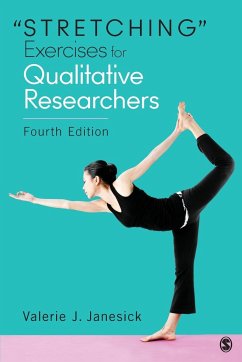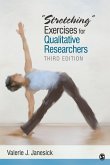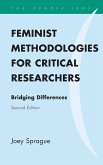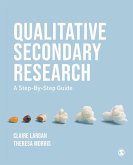Valerie J. Janesick
Stretching Exercises for Qualitative Researchers
Valerie J. Janesick
Stretching Exercises for Qualitative Researchers
- Broschiertes Buch
- Merkliste
- Auf die Merkliste
- Bewerten Bewerten
- Teilen
- Produkt teilen
- Produkterinnerung
- Produkterinnerung
In the new Fourth Edition of her inventive, one-of-a-kind book, "Stretching" Exercises for Qualitative Researchers, author Valerie J. Janesick uses dance, yoga, and meditation metaphors to help researchers tap into the intuitive and creative side of their research. In every chapter, "stretching" exercises help readers develop, practice, and hone fieldwork skills and vital habits of mind such as observation, interviewing, writing, creativity, technology, and analysis. While reading the book and working through the exercises, readers can complete a researcher's reflective journal-an invaluable tool that will remain useful throughout their careers.…mehr
Andere Kunden interessierten sich auch für
![Stretching Exercises for Qualitative Researchers Stretching Exercises for Qualitative Researchers]() Valerie J JanesickStretching Exercises for Qualitative Researchers82,99 €
Valerie J JanesickStretching Exercises for Qualitative Researchers82,99 €![Qualitative Research Approach A pocketbook for early researchers Qualitative Research Approach A pocketbook for early researchers]() Martin KuriaQualitative Research Approach A pocketbook for early researchers30,99 €
Martin KuriaQualitative Research Approach A pocketbook for early researchers30,99 €![Feminist Methodologies for Critical Researchers Feminist Methodologies for Critical Researchers]() Joey SpragueFeminist Methodologies for Critical Researchers139,99 €
Joey SpragueFeminist Methodologies for Critical Researchers139,99 €![Qualitative Secondary Research Qualitative Secondary Research]() Claire LarganQualitative Secondary Research34,99 €
Claire LarganQualitative Secondary Research34,99 €![Formulating Safety Strategies for Peace Researchers Formulating Safety Strategies for Peace Researchers]() Scott MeyerFormulating Safety Strategies for Peace Researchers33,99 €
Scott MeyerFormulating Safety Strategies for Peace Researchers33,99 €![Research Skills for Academicians: A Survival Toolkit for Researchers Research Skills for Academicians: A Survival Toolkit for Researchers]() John Isaac MwitaResearch Skills for Academicians: A Survival Toolkit for Researchers43,99 €
John Isaac MwitaResearch Skills for Academicians: A Survival Toolkit for Researchers43,99 €![Consulting skills for social researchers Consulting skills for social researchers]() Simon HaslamConsulting skills for social researchers23,99 €
Simon HaslamConsulting skills for social researchers23,99 €-
-
-
In the new Fourth Edition of her inventive, one-of-a-kind book, "Stretching" Exercises for Qualitative Researchers, author Valerie J. Janesick uses dance, yoga, and meditation metaphors to help researchers tap into the intuitive and creative side of their research. In every chapter, "stretching" exercises help readers develop, practice, and hone fieldwork skills and vital habits of mind such as observation, interviewing, writing, creativity, technology, and analysis. While reading the book and working through the exercises, readers can complete a researcher's reflective journal-an invaluable tool that will remain useful throughout their careers.
Hinweis: Dieser Artikel kann nur an eine deutsche Lieferadresse ausgeliefert werden.
Hinweis: Dieser Artikel kann nur an eine deutsche Lieferadresse ausgeliefert werden.
Produktdetails
- Produktdetails
- Verlag: Sage Publications, Inc
- 4. Auflage
- Seitenzahl: 320
- Erscheinungstermin: 12. August 2015
- Englisch
- Abmessung: 229mm x 152mm x 17mm
- Gewicht: 466g
- ISBN-13: 9781483358277
- ISBN-10: 1483358275
- Artikelnr.: 42606919
- Herstellerkennzeichnung
- Libri GmbH
- Europaallee 1
- 36244 Bad Hersfeld
- gpsr@libri.de
- Verlag: Sage Publications, Inc
- 4. Auflage
- Seitenzahl: 320
- Erscheinungstermin: 12. August 2015
- Englisch
- Abmessung: 229mm x 152mm x 17mm
- Gewicht: 466g
- ISBN-13: 9781483358277
- ISBN-10: 1483358275
- Artikelnr.: 42606919
- Herstellerkennzeichnung
- Libri GmbH
- Europaallee 1
- 36244 Bad Hersfeld
- gpsr@libri.de
Valerie J. Janesick (PhD, Michigan State University) is Professor of Educational Leadership and Policy Studies, in the department of Leadership, Counseling, Adult, Career and Higher Education, LCACHE, University of South Florida, Tampa. She teaches classes in qualitative research methods, curriculum theory and inquiry, and ethics in leadership. Her latest book, "Contemplative Qualitative Inquiry: Practicing the Zen of Research (2015) Left Coast Press, argues for the use of Zen approaches to qualitative inquiry cast as Contemplative Qualitative Inquiry. Her chapters in the Handbook of Qualitative Research (first and second editions) use dance and the arts as metaphors for understanding research. Her book, Oral History for the Qualitative Researcher: Choreographing the Story (2010), Guilford Press, incorporates, poetry, photography and the arts to capture lived experience. She serves on the editorial board of The Qualitative Report, and the International Journal of Qualitative Methods. She continues to take classes in yoga and meditation.
Chapter 1. Qualitative Research and Habits of Mind
Identifying, Practicing, and Developing Habits
Getting Feedback and Writing About It
Finding Your Theoretical Habit
Developing Habits of Mind
Terms Used to Describe Qualitative Research
Characteristics of Qualitative Work
Questions Suited to Qualitative Research Methods
Using Theory in Qualitative Research
Artistic Approaches to Qualitative Research
Contemplative Qualitative Inquiry and the Zen of Research
Why Try These Exercises?
How to Use This Book
The Audience for This Book
Suggested Resources
Chapter 2. The Observation, Reflection, and Writing Habit
Exercise 2.1: Observing a Still Life Scene
Description of a Still Life Scene
Constructing a Researcher Reflective Portfolio
Types of Portfolios and Assessment
How the Electronic Portfolio Works
Portfolio Contents
Exercise 2.2: Physical Description of This Setting
Exercise 2.3: Observation in the Home or Workplace
Exercise 2.4: Description of a Familiar Person or a Stranger
The Qualities of Exemplary Case Studies
Exercise 2.5: Observing at an Art Museum or at a Movie
Exercise 2.6: Observing an Animal at Home, the Zoo, or a Pet Shop
Exercise 2.7: Drawing to Become a Better Observer: Drawing Upside Down
Chapter 3. Advancing the Observation, Reflection, and Writing Habit
Exercise 3.1: Nonparticipant Observation Assignment
Exercise 3.2: Reflecting to Strengthen the Writing Habit
Exercise 3.3: Writing Your Educational Autobiography
Exercise 3.4: Writing a Pedagogical Letter
Next Steps: Self-Evaluation
Pitfalls in Observation
Chapter Summary
Suggested Resources
Chapter 4. The Interview and Writing Habit
Two People Talking, Communicating, and Constructing Meaning
Types of Interview Questions
Preparing Questions
Examples of Interview Questions From a Recent Study
Exercise 4.1: Interviewing Someone You Know
Exercise 4.2: Interviewing a Stranger
Exercise 4.3: The Oral History Interview
Exercise 4.4: The Focus Group Interview Demonstration Exercise
Exercise 4.5: Presenting Interview Data as a Found Data Poem
Exercise 4.6: Describing Your Role in a Research Project as Identity Poetry
Exercise 4.7: The Digital, Virtual Interview and Google Groups
Exercise 4.8: Interviewing Someone Twice
Exercise 4.9: Practicing an Online Interview
Conducting Qualitative Interviews: Some Rules of Thumb
Chapter Summary
Suggested Resources
Chapter 5. The Creative Habit
The Role of the Researcher and the Researcher Reflective Journal
Exercise 5.1: Variations on Writing Your Name
Exercise 5.2: The Camera as an Extension of the Eye, the Eye as an
Extension of the Soul
Exercise 5.3: Building a Collage: My Role as a Researcher
Exercise 5.4: Constructing a YaYa Box or Making a Quilt Patch
The Qualitative Researcher and the Intuitive Sense
Exercise 5.5: Writing About Your Favorite Vegetable
Serendipity
Intuition, Creativity, and Compassion in Research
The Researcher Reflective Journal as Creative Act
Exercise 5.6: Your Journey
Future Directions
Exercise 5.7: Reflective Journal Writing Practice in Dialogue Form
Exercise 5.8: Haiku and Any Form of Poetry on the Role of the Researcher
Exercise 5.9: Framed Photograph and Narrative Writing Exercise
Exercise 5.10: Writing Timeline Exercise
Chapter Summary
Suggested Resources
Chapter 6. The Analysis Habit
The Qualitative Researcher as Contemplative and Mindful
Checkpoints for Data Analysis, Reporting, and Interpretation
Various Approaches to Analysis and Interpretation of Data
Ethics and the Qualitative Researcher
True Stories: Sample Ethical Dilemmas
Attributes of the Qualitative Researcher
Qualitative Researchers Interacting With Institutional Review Boards, IRBs
Chapter Summary
Exercise 6.1: Design and Create a Cover for Your Researcher Reflective
Journal
Exercise 6.2: Describe Your Favorite Meal
Exercise 6.3: Writing About Change in Yourself in Any Five-Year Period
Chapter 7. The Technology Habit
Benefits for Small-Scale Studies Using Technology
The Context
The Power of Skype Interviewing
Next Steps: Editing Through Audacity
Transcription With Express Scribe, Dragon, iTalk, iSpeak, and MS Word
Voice Recognition Software
Researcher Reflective Portfolios
Excel as a Text/Data Analysis Tool
Analysis Strategies From MS Word to MS Excel
Overall Virtual Interview: From Collection to Analysis
Electronic Mailing Lists, Websites, Journals, and Software Options
Exercise 7.1: Conducting and Transcribing a Skype Interview Using Express
Scribe for Transcription
Exercise 7.2: Create a Word Cloud Using Wordle and One With Tagxedo
Exercise 7.3: Create a Glog, a Poster Online Through Glogster
Chapter Summary
Identifying, Practicing, and Developing Habits
Getting Feedback and Writing About It
Finding Your Theoretical Habit
Developing Habits of Mind
Terms Used to Describe Qualitative Research
Characteristics of Qualitative Work
Questions Suited to Qualitative Research Methods
Using Theory in Qualitative Research
Artistic Approaches to Qualitative Research
Contemplative Qualitative Inquiry and the Zen of Research
Why Try These Exercises?
How to Use This Book
The Audience for This Book
Suggested Resources
Chapter 2. The Observation, Reflection, and Writing Habit
Exercise 2.1: Observing a Still Life Scene
Description of a Still Life Scene
Constructing a Researcher Reflective Portfolio
Types of Portfolios and Assessment
How the Electronic Portfolio Works
Portfolio Contents
Exercise 2.2: Physical Description of This Setting
Exercise 2.3: Observation in the Home or Workplace
Exercise 2.4: Description of a Familiar Person or a Stranger
The Qualities of Exemplary Case Studies
Exercise 2.5: Observing at an Art Museum or at a Movie
Exercise 2.6: Observing an Animal at Home, the Zoo, or a Pet Shop
Exercise 2.7: Drawing to Become a Better Observer: Drawing Upside Down
Chapter 3. Advancing the Observation, Reflection, and Writing Habit
Exercise 3.1: Nonparticipant Observation Assignment
Exercise 3.2: Reflecting to Strengthen the Writing Habit
Exercise 3.3: Writing Your Educational Autobiography
Exercise 3.4: Writing a Pedagogical Letter
Next Steps: Self-Evaluation
Pitfalls in Observation
Chapter Summary
Suggested Resources
Chapter 4. The Interview and Writing Habit
Two People Talking, Communicating, and Constructing Meaning
Types of Interview Questions
Preparing Questions
Examples of Interview Questions From a Recent Study
Exercise 4.1: Interviewing Someone You Know
Exercise 4.2: Interviewing a Stranger
Exercise 4.3: The Oral History Interview
Exercise 4.4: The Focus Group Interview Demonstration Exercise
Exercise 4.5: Presenting Interview Data as a Found Data Poem
Exercise 4.6: Describing Your Role in a Research Project as Identity Poetry
Exercise 4.7: The Digital, Virtual Interview and Google Groups
Exercise 4.8: Interviewing Someone Twice
Exercise 4.9: Practicing an Online Interview
Conducting Qualitative Interviews: Some Rules of Thumb
Chapter Summary
Suggested Resources
Chapter 5. The Creative Habit
The Role of the Researcher and the Researcher Reflective Journal
Exercise 5.1: Variations on Writing Your Name
Exercise 5.2: The Camera as an Extension of the Eye, the Eye as an
Extension of the Soul
Exercise 5.3: Building a Collage: My Role as a Researcher
Exercise 5.4: Constructing a YaYa Box or Making a Quilt Patch
The Qualitative Researcher and the Intuitive Sense
Exercise 5.5: Writing About Your Favorite Vegetable
Serendipity
Intuition, Creativity, and Compassion in Research
The Researcher Reflective Journal as Creative Act
Exercise 5.6: Your Journey
Future Directions
Exercise 5.7: Reflective Journal Writing Practice in Dialogue Form
Exercise 5.8: Haiku and Any Form of Poetry on the Role of the Researcher
Exercise 5.9: Framed Photograph and Narrative Writing Exercise
Exercise 5.10: Writing Timeline Exercise
Chapter Summary
Suggested Resources
Chapter 6. The Analysis Habit
The Qualitative Researcher as Contemplative and Mindful
Checkpoints for Data Analysis, Reporting, and Interpretation
Various Approaches to Analysis and Interpretation of Data
Ethics and the Qualitative Researcher
True Stories: Sample Ethical Dilemmas
Attributes of the Qualitative Researcher
Qualitative Researchers Interacting With Institutional Review Boards, IRBs
Chapter Summary
Exercise 6.1: Design and Create a Cover for Your Researcher Reflective
Journal
Exercise 6.2: Describe Your Favorite Meal
Exercise 6.3: Writing About Change in Yourself in Any Five-Year Period
Chapter 7. The Technology Habit
Benefits for Small-Scale Studies Using Technology
The Context
The Power of Skype Interviewing
Next Steps: Editing Through Audacity
Transcription With Express Scribe, Dragon, iTalk, iSpeak, and MS Word
Voice Recognition Software
Researcher Reflective Portfolios
Excel as a Text/Data Analysis Tool
Analysis Strategies From MS Word to MS Excel
Overall Virtual Interview: From Collection to Analysis
Electronic Mailing Lists, Websites, Journals, and Software Options
Exercise 7.1: Conducting and Transcribing a Skype Interview Using Express
Scribe for Transcription
Exercise 7.2: Create a Word Cloud Using Wordle and One With Tagxedo
Exercise 7.3: Create a Glog, a Poster Online Through Glogster
Chapter Summary
Chapter 1. Qualitative Research and Habits of Mind
Identifying, Practicing, and Developing Habits
Getting Feedback and Writing About It
Finding Your Theoretical Habit
Developing Habits of Mind
Terms Used to Describe Qualitative Research
Characteristics of Qualitative Work
Questions Suited to Qualitative Research Methods
Using Theory in Qualitative Research
Artistic Approaches to Qualitative Research
Contemplative Qualitative Inquiry and the Zen of Research
Why Try These Exercises?
How to Use This Book
The Audience for This Book
Suggested Resources
Chapter 2. The Observation, Reflection, and Writing Habit
Exercise 2.1: Observing a Still Life Scene
Description of a Still Life Scene
Constructing a Researcher Reflective Portfolio
Types of Portfolios and Assessment
How the Electronic Portfolio Works
Portfolio Contents
Exercise 2.2: Physical Description of This Setting
Exercise 2.3: Observation in the Home or Workplace
Exercise 2.4: Description of a Familiar Person or a Stranger
The Qualities of Exemplary Case Studies
Exercise 2.5: Observing at an Art Museum or at a Movie
Exercise 2.6: Observing an Animal at Home, the Zoo, or a Pet Shop
Exercise 2.7: Drawing to Become a Better Observer: Drawing Upside Down
Chapter 3. Advancing the Observation, Reflection, and Writing Habit
Exercise 3.1: Nonparticipant Observation Assignment
Exercise 3.2: Reflecting to Strengthen the Writing Habit
Exercise 3.3: Writing Your Educational Autobiography
Exercise 3.4: Writing a Pedagogical Letter
Next Steps: Self-Evaluation
Pitfalls in Observation
Chapter Summary
Suggested Resources
Chapter 4. The Interview and Writing Habit
Two People Talking, Communicating, and Constructing Meaning
Types of Interview Questions
Preparing Questions
Examples of Interview Questions From a Recent Study
Exercise 4.1: Interviewing Someone You Know
Exercise 4.2: Interviewing a Stranger
Exercise 4.3: The Oral History Interview
Exercise 4.4: The Focus Group Interview Demonstration Exercise
Exercise 4.5: Presenting Interview Data as a Found Data Poem
Exercise 4.6: Describing Your Role in a Research Project as Identity Poetry
Exercise 4.7: The Digital, Virtual Interview and Google Groups
Exercise 4.8: Interviewing Someone Twice
Exercise 4.9: Practicing an Online Interview
Conducting Qualitative Interviews: Some Rules of Thumb
Chapter Summary
Suggested Resources
Chapter 5. The Creative Habit
The Role of the Researcher and the Researcher Reflective Journal
Exercise 5.1: Variations on Writing Your Name
Exercise 5.2: The Camera as an Extension of the Eye, the Eye as an
Extension of the Soul
Exercise 5.3: Building a Collage: My Role as a Researcher
Exercise 5.4: Constructing a YaYa Box or Making a Quilt Patch
The Qualitative Researcher and the Intuitive Sense
Exercise 5.5: Writing About Your Favorite Vegetable
Serendipity
Intuition, Creativity, and Compassion in Research
The Researcher Reflective Journal as Creative Act
Exercise 5.6: Your Journey
Future Directions
Exercise 5.7: Reflective Journal Writing Practice in Dialogue Form
Exercise 5.8: Haiku and Any Form of Poetry on the Role of the Researcher
Exercise 5.9: Framed Photograph and Narrative Writing Exercise
Exercise 5.10: Writing Timeline Exercise
Chapter Summary
Suggested Resources
Chapter 6. The Analysis Habit
The Qualitative Researcher as Contemplative and Mindful
Checkpoints for Data Analysis, Reporting, and Interpretation
Various Approaches to Analysis and Interpretation of Data
Ethics and the Qualitative Researcher
True Stories: Sample Ethical Dilemmas
Attributes of the Qualitative Researcher
Qualitative Researchers Interacting With Institutional Review Boards, IRBs
Chapter Summary
Exercise 6.1: Design and Create a Cover for Your Researcher Reflective
Journal
Exercise 6.2: Describe Your Favorite Meal
Exercise 6.3: Writing About Change in Yourself in Any Five-Year Period
Chapter 7. The Technology Habit
Benefits for Small-Scale Studies Using Technology
The Context
The Power of Skype Interviewing
Next Steps: Editing Through Audacity
Transcription With Express Scribe, Dragon, iTalk, iSpeak, and MS Word
Voice Recognition Software
Researcher Reflective Portfolios
Excel as a Text/Data Analysis Tool
Analysis Strategies From MS Word to MS Excel
Overall Virtual Interview: From Collection to Analysis
Electronic Mailing Lists, Websites, Journals, and Software Options
Exercise 7.1: Conducting and Transcribing a Skype Interview Using Express
Scribe for Transcription
Exercise 7.2: Create a Word Cloud Using Wordle and One With Tagxedo
Exercise 7.3: Create a Glog, a Poster Online Through Glogster
Chapter Summary
Identifying, Practicing, and Developing Habits
Getting Feedback and Writing About It
Finding Your Theoretical Habit
Developing Habits of Mind
Terms Used to Describe Qualitative Research
Characteristics of Qualitative Work
Questions Suited to Qualitative Research Methods
Using Theory in Qualitative Research
Artistic Approaches to Qualitative Research
Contemplative Qualitative Inquiry and the Zen of Research
Why Try These Exercises?
How to Use This Book
The Audience for This Book
Suggested Resources
Chapter 2. The Observation, Reflection, and Writing Habit
Exercise 2.1: Observing a Still Life Scene
Description of a Still Life Scene
Constructing a Researcher Reflective Portfolio
Types of Portfolios and Assessment
How the Electronic Portfolio Works
Portfolio Contents
Exercise 2.2: Physical Description of This Setting
Exercise 2.3: Observation in the Home or Workplace
Exercise 2.4: Description of a Familiar Person or a Stranger
The Qualities of Exemplary Case Studies
Exercise 2.5: Observing at an Art Museum or at a Movie
Exercise 2.6: Observing an Animal at Home, the Zoo, or a Pet Shop
Exercise 2.7: Drawing to Become a Better Observer: Drawing Upside Down
Chapter 3. Advancing the Observation, Reflection, and Writing Habit
Exercise 3.1: Nonparticipant Observation Assignment
Exercise 3.2: Reflecting to Strengthen the Writing Habit
Exercise 3.3: Writing Your Educational Autobiography
Exercise 3.4: Writing a Pedagogical Letter
Next Steps: Self-Evaluation
Pitfalls in Observation
Chapter Summary
Suggested Resources
Chapter 4. The Interview and Writing Habit
Two People Talking, Communicating, and Constructing Meaning
Types of Interview Questions
Preparing Questions
Examples of Interview Questions From a Recent Study
Exercise 4.1: Interviewing Someone You Know
Exercise 4.2: Interviewing a Stranger
Exercise 4.3: The Oral History Interview
Exercise 4.4: The Focus Group Interview Demonstration Exercise
Exercise 4.5: Presenting Interview Data as a Found Data Poem
Exercise 4.6: Describing Your Role in a Research Project as Identity Poetry
Exercise 4.7: The Digital, Virtual Interview and Google Groups
Exercise 4.8: Interviewing Someone Twice
Exercise 4.9: Practicing an Online Interview
Conducting Qualitative Interviews: Some Rules of Thumb
Chapter Summary
Suggested Resources
Chapter 5. The Creative Habit
The Role of the Researcher and the Researcher Reflective Journal
Exercise 5.1: Variations on Writing Your Name
Exercise 5.2: The Camera as an Extension of the Eye, the Eye as an
Extension of the Soul
Exercise 5.3: Building a Collage: My Role as a Researcher
Exercise 5.4: Constructing a YaYa Box or Making a Quilt Patch
The Qualitative Researcher and the Intuitive Sense
Exercise 5.5: Writing About Your Favorite Vegetable
Serendipity
Intuition, Creativity, and Compassion in Research
The Researcher Reflective Journal as Creative Act
Exercise 5.6: Your Journey
Future Directions
Exercise 5.7: Reflective Journal Writing Practice in Dialogue Form
Exercise 5.8: Haiku and Any Form of Poetry on the Role of the Researcher
Exercise 5.9: Framed Photograph and Narrative Writing Exercise
Exercise 5.10: Writing Timeline Exercise
Chapter Summary
Suggested Resources
Chapter 6. The Analysis Habit
The Qualitative Researcher as Contemplative and Mindful
Checkpoints for Data Analysis, Reporting, and Interpretation
Various Approaches to Analysis and Interpretation of Data
Ethics and the Qualitative Researcher
True Stories: Sample Ethical Dilemmas
Attributes of the Qualitative Researcher
Qualitative Researchers Interacting With Institutional Review Boards, IRBs
Chapter Summary
Exercise 6.1: Design and Create a Cover for Your Researcher Reflective
Journal
Exercise 6.2: Describe Your Favorite Meal
Exercise 6.3: Writing About Change in Yourself in Any Five-Year Period
Chapter 7. The Technology Habit
Benefits for Small-Scale Studies Using Technology
The Context
The Power of Skype Interviewing
Next Steps: Editing Through Audacity
Transcription With Express Scribe, Dragon, iTalk, iSpeak, and MS Word
Voice Recognition Software
Researcher Reflective Portfolios
Excel as a Text/Data Analysis Tool
Analysis Strategies From MS Word to MS Excel
Overall Virtual Interview: From Collection to Analysis
Electronic Mailing Lists, Websites, Journals, and Software Options
Exercise 7.1: Conducting and Transcribing a Skype Interview Using Express
Scribe for Transcription
Exercise 7.2: Create a Word Cloud Using Wordle and One With Tagxedo
Exercise 7.3: Create a Glog, a Poster Online Through Glogster
Chapter Summary








